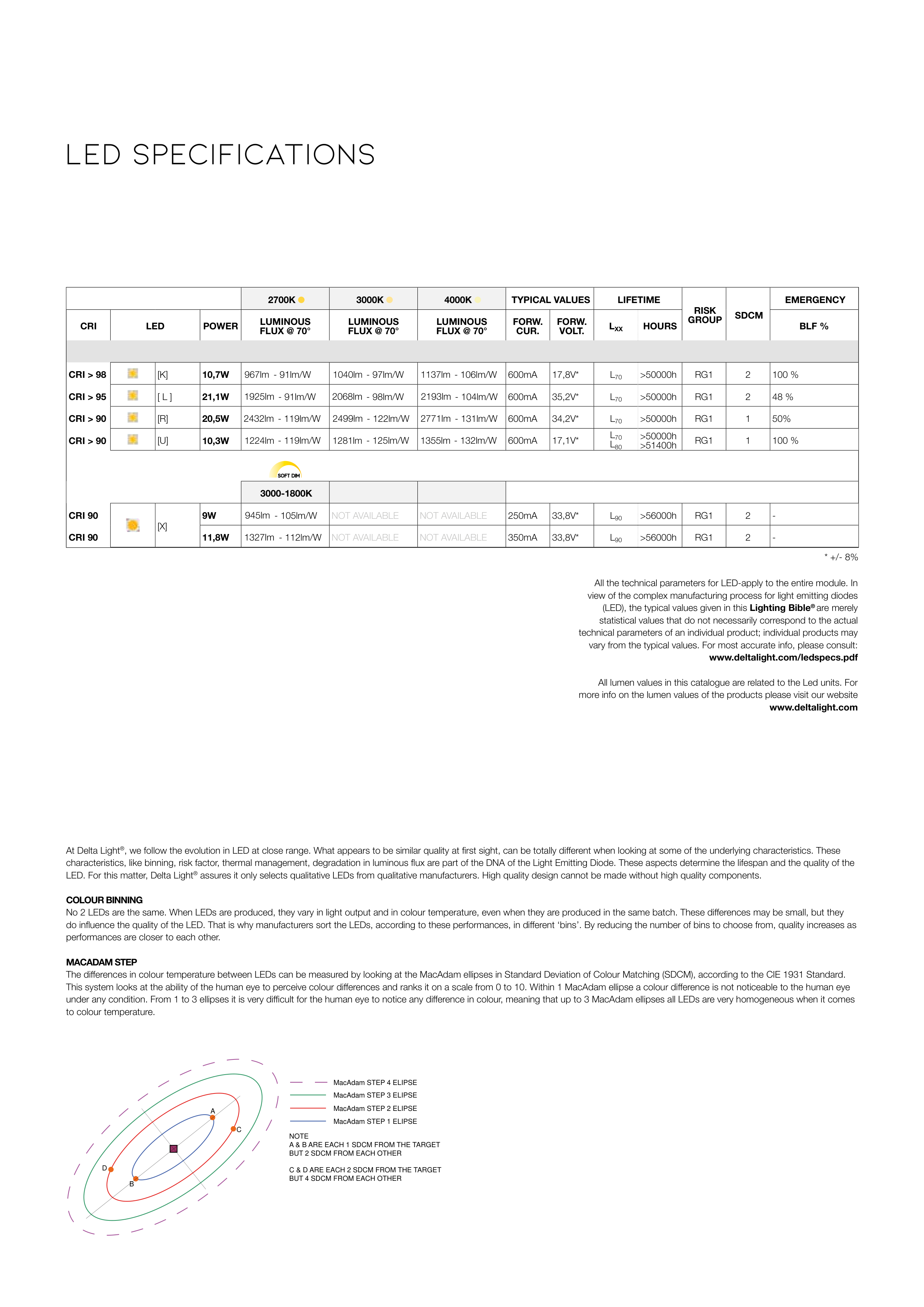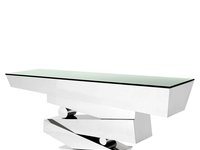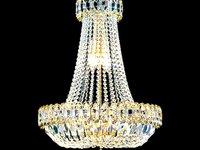2700K
3000K
4000K
TYPICAL VALUES
LIFETIME
RISK
GROUP
SDCM
EMERGENCY
CRI
LED
POWER
LUMINOUS
FLUX @ 70°
LUMINOUS
FLUX @ 70°
LUMINOUS
FLUX @ 70°
FORW.
CUR.
FORW.
VOLT.
LXX
HOURS
BLF %
CRI > 98
[K]
10,7W
- 91lm/W
- 97lm/W
- 106lm/W
600mA
17,8V*
L70
>50000h
RG1
2
100 %
CRI > 95
[ L ]
21,1W
- 91lm/W
- 98lm/W
- 104lm/W
600mA
35,2V*
L70
>50000h
RG1
2
48 %
CRI > 90
[R]
20,5W
- 119lm/W
- 122lm/W
- 131lm/W
600mA
34,2V*
L70
>50000h
RG1
1
50%
CRI > 90
[U]
10,3W
- 119lm/W
- 125lm/W
- 132lm/W
600mA
17,1V*
L70
L80
>50000h
>51400h
RG1
1
100 %
3000-1800K
CRI 90
[X]
9W
- 105lm/W
NOT AVAILABLE
NOT AVAILABLE
250mA
33,8V*
L90
>56000h
RG1
2
-
CRI 90
11,8W
- 112lm/W
NOT AVAILABLE
NOT AVAILABLE
350mA
33,8V*
L90
>56000h
RG1
2
-
All the technical parameters for LED-apply to the entire module. In
view of the complex manufacturing process for light emitting diodes
(LED), the typical values given in this Lighting Bible® are merely
statistical values that do not necessarily correspond to the actual
technical parameters of an individual product; individual products may
vary from the typical values. For most accurate info, please consult:
www.deltalight.com/ledspecs.pdf
All lumen values in this catalogue are related to the Led units. For
more info on the lumen values of the products please visit our website
www.deltalight.com
* +/- 8%
6000K
MacAdam STEP 4 ELIPSE
MacAdam STEP 3 ELIPSE
MacAdam STEP 2 ELIPSE
MacAdam STEP 1 ELIPSE
NOTE
A & B ARE EACH 1 SDCM FROM THE TARGET
BUT 2 SDCM FROM EACH OTHER
C & D ARE EACH 2 SDCM FROM THE TARGET
BUT 4 SDCM FROM EACH OTHER
400
0
20
40
60
80
100
450
650
750
500
550
600
700
Relative radiant Power (%)
Wavelength (nm)
Wavelength (nm)
400
A
B
D
C
0.0
0.2
0.4
0.6
0.8
1.0
1.2
450
650
750
500
550
600
700
800
Relative Intesity
Typical Color Spectrum
6000K
3000K
4000K
At Delta Light®, we follow the evolution in LED at close range. What appears to be similar quality at first sight, can be totally different when looking at some of the underlying characteristics. These
characteristics, like binning, risk factor, thermal management, degradation in luminous flux are part of the DNA of the Light Emitting Diode. These aspects determine the lifespan and the quality of the
LED. For this matter, Delta Light® assures it only selects qualitative LEDs from qualitative manufacturers. High quality design cannot be made without high quality components.
COLOUR BINNING
No 2 LEDs are the same. When LEDs are produced, they vary in light output and in colour temperature, even when they are produced in the same batch. These differences may be small, but they
do influence the quality of the LED. That is why manufacturers sort the LEDs, according to these performances, in different ‘bins’. By reducing the number of bins to choose from, quality increases as
performances are closer to each other.
MACADAM STEP
The differences in colour temperature between LEDs can be measured by looking at the MacAdam ellipses in Standard Deviation of Colour Matching (SDCM), according to the CIE 1931 Standard.
This system looks at the ability of the human eye to perceive colour differences and ranks it on a scale from 0 to 10. Within 1 MacAdam ellipse a colour difference is not noticeable to the human eye
under any condition. From 1 to 3 ellipses it is very difficult for the human eye to notice any difference in colour, meaning that up to 3 MacAdam ellipses all LEDs are very homogeneous when it comes
to colour temperature.
LED SPECIFICATIONS







